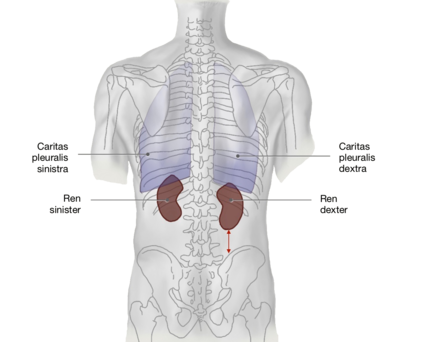Niere (Ren)/en: Unterschied zwischen den Versionen
Becher (Diskussion | Beiträge) (Die Seite wurde neu angelegt: „The following organs were removed in the <!--[segmenter_snapshot ren 0]--> "WebViewer"<!--[/]-->: all intraperitoneal organs, the secondary retroperitoneal col…“) |
Becher (Diskussion | Beiträge) (Die Seite wurde neu angelegt: „==Neighbouring organs of the kidneys==“) |
||
| Zeile 47: | Zeile 47: | ||
| − | == | + | ==Neighbouring organs of the kidneys== |
[[File:RenNachbar.png|530px|height:300px|right|Niere: Nachbarorgane der Niere]] | [[File:RenNachbar.png|530px|height:300px|right|Niere: Nachbarorgane der Niere]] | ||
Version vom 3. Januar 2020, 14:41 Uhr
Inhaltsverzeichnis
Structure and shape of the kidneys
| without annotations | View from ventral | View from dorsal | View from medial |
The kidneys are each about 12 cm long, 6 cm wide, weigh between 150-180 g and have the shape of a bean. The following structures can be distinguished:
- two poles (Extremitas superior/inferior),
- two surfaces (Facies anterior/posterior) and
- two margins (Margo lateralis/medialis).
The two poles join at the inner margin and form the renal hilus (Hilum renale). This serves as a gate for inflowing and outflowing vessels. The kidney is surrounded by a capsule of tight connective tissue (Capsula fibrosa renis). The surface of the kidney is delicately furrowed due to the history of its development. In contrast to the blood vessels, the ureter is often slightly dorsally displaced and exits the renal pelvis below the vessels.
Projection of the kidneys onto the trunk
The kidney (Ren) is a paired urinary organ located retroperitoneally in the abdominal cavity.
Due to its central location it touches almost all organs. They are located between the 12th thoracic and 3rd lumbar vertebra, while the hilum is located at the level of the 2nd lumbar vertebra.
The liver is ventral to the kidney. The space in between is called Recessus hepatorenalis and represents the deepest space of the abdominal cavity in humans. Therefore it is a popular site for pathological fluid deposition. The kidneys project a triangle onto the trunk which extends from the lower edge of the bony thorax to the lateral edge of the spinal column.
View from ventral: The kidneys lie retroperitoneally under the diaphragm. They are therefore passively moved with the respiration. In severe diseases such as metastatic tumours, this can lead to the disappearance of the fat capsule (capsula adiposa), in which the kidney is usually firmly integrated, and to the lowering of the kidneys. Vessels and the ureter can be trapped and disturbances in renal perfusion can be caused.
View from dorsal: The kidneys are dorsally overlapped by the pleural cavities and the right kidney is less distant from the iliac crest.
Kidneys in situ
<segmenter height="300px" width="500px" border="1">https://dornheim.cloud/index.php/apps/segmenter/embedding/view?identifier=vew4BFxXxksp</segmenter>
The following organs were removed in the "WebViewer": all intraperitoneal organs, the secondary retroperitoneal colon sections and capsula adiposa in front of the kidneys. The duodenum and pancreas were not removed. At the posterior wall of the peritoneal cavity the kidneys are superimposed by the ligaments of Colon ascendens and descendens. Although parts of the duodenum, left and right colonic flexure and pancreas are located in direct proximity to the kidneys, they are separated by connective tissue and fat of the capsula adiposa.
Neighbouring organs of the kidneys
Die vorderen Flächen der Nieren stehen im engen Kontakt zu zahlreichen Organen des Abdomens. Die Nebennieren sind ihnen dabei am nächsten, aufgrund der Capsula adiposa berühren sie sich jedoch nicht. Die anderen Nachbarorgane hinterlassen auf der formstabilen Niere, anders als bei der Leber, keine Abdrücke und sind daher nur topografisch relevant. Die retroperitoneal liegenden Nieren sind von den retroperitonealen Organen durch Faszien des Nierenlagers isoliert und von den intraperitonealen Organen außerdem durch das Peritoneum.
Makroskopischer Aufbau der Niere (Demnächst)
weiterführende Links


